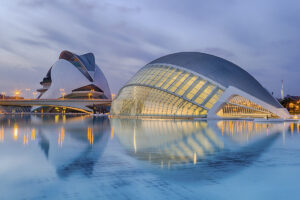I am sure you have read about the deadly flash floods that have devastated the Eastern side of the Iberian Peninsula during the last few weeks. The city of Valencia, where I was born, was spared, but the province was plummeted with a year’s worth of rain in a few hours. At least 220 people died. The precipitation was accompanied by strong winds of tornado force caused by a meteorologic phenomenon called DANA (Depresión Aislada en Niveles Altos, an isolated depression in high altitudes). This term is relatively new; it used to be called “La Gota Fría,” (the cold drop), when it consisted of cold rains with hail and strong winds. A DANA now is caused during the last weeks of summer and beginning of autumn, when the Mediterranean Sea is still very warm, and the cold fronts arrive from the mountains, creating circular storms that can last for days. Usually, a DANA is not as destructive as the one this year, because it arrived unexpectedly and the local authorities failed to warn the people, particularly in the rural regions.
Matt Taylor, a meteorologist from the BBC, confirms that, although there have been similar storms in the past—there was one in 1973 of similar strength to this year’s DANA—they have become more common due to climate change. The warmer Mediterranean creates more humidity and energy that fuels the cold fronts. The question for American readers is to wonder how cities, regions and even countries can prosper without the realization of the impact of climate change. How is the United States going to fare with a president who doesn’t believe in global warming?
Growing up in Madrid, I remember the city of Valencia experiencing serious floods and we were worried about the rest of my family living there. We had lived on Turia Street—named after the river itself for its proximity. On one occasion my father had to take a bus, since we didn’t have a car then, to check on the two elderly aunts who had moved into our old home. The last flood in Valencia was in 1957, on the 13th-14th of October, probably the year of my father’s trip. On summer visits we could see marks on the shops’ walls marking how high the water had raised Now you may ask, why doesn’t the city of Valencia flood anymore?
To give credit where credit is due, Francisco Franco’s government financed a series of plans to divert the River Turia outside Valencia, the so-called “Solución Sur” (the South Solution), which took from 1958-1973 to complete. Not only was the flood problem resolved, but the city experienced a huge revival with this premium real estate in its midst.  The old riverbed has given way to ten bridges, some of them to circumvent highways and trains as well. For example, there is a freeway between the harbor and the airport, sidestepping the city and avoiding traffic.
The old riverbed has given way to ten bridges, some of them to circumvent highways and trains as well. For example, there is a freeway between the harbor and the airport, sidestepping the city and avoiding traffic.
The most beautiful result of this plan has been the Jardín del Turia (the Turia River Garden), which is one of the largest urban gardens in Spain. In addition to gardens, fountains, a zoo, athletic fields, green spaces for fairs and large events such as the circus and fireworks, the riverbed houses the monumental works by Santiago Calatrava and other famous architects.
Calatrava was born in Valencia in 1951 and he is also an engineer and a sculptor, thus the originality and visual impact of his structures created with steel, glass and concrete in the whimsical shapes of birds, turtles or dinosaurs.  Just in the Jardín del Turia we can find the Ciudad de las Artes y las Ciencias (the City of Arts and Sciences), L’Hemispheric (the planetarium, in the shape of an eye reflected in a lake), the Palacio de las Artes and the Museo de las Ciencias Príncipe Felipe (that looks like the skeleton of a whale) and the most striking, the Palacio de las Artes Reina Sofía (known as the tiara), which houses the Orchestra of the Valencian Community.
Just in the Jardín del Turia we can find the Ciudad de las Artes y las Ciencias (the City of Arts and Sciences), L’Hemispheric (the planetarium, in the shape of an eye reflected in a lake), the Palacio de las Artes and the Museo de las Ciencias Príncipe Felipe (that looks like the skeleton of a whale) and the most striking, the Palacio de las Artes Reina Sofía (known as the tiara), which houses the Orchestra of the Valencian Community.
No wonder Valencia greets over three million tourists a year and was voted as the best “green” city in Europe this year, and one of the fifty-two places to visit in 2024 by the New York Times.

Hoping to visit Valencia one day! The garden you describe sounds magical! Cécile
With all the travel you have planned, Valencia can wait. Have a wonderful trip! Love, Concha
Concha, I especially enjoyed reading this issue of your Epílogos, Susan
Thanks so much, Susan!
Concha